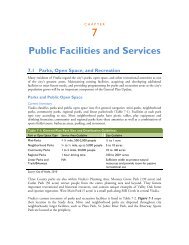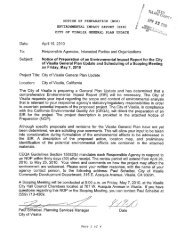General Plan Update Review Committee Draft Elements Part 2 For ...
General Plan Update Review Committee Draft Elements Part 2 For ...
General Plan Update Review Committee Draft Elements Part 2 For ...
You also want an ePaper? Increase the reach of your titles
YUMPU automatically turns print PDFs into web optimized ePapers that Google loves.
State and national health-based ambient air quality<br />
standards have been established. EPA identifies these<br />
pollutants as criteria air pollutants because the agency<br />
has regulated them by developing specific public<br />
health- and welfare-based criteria as the basis for<br />
setting permissible levels. Ozone, carbon monoxide<br />
(CO), nitrogen dioxide (NO 2 ), sulfur dioxide (SO 2 ),<br />
particulate matter (PM), and lead are the six criteria<br />
air pollutants.<br />
Ozone<br />
Ozone is a respiratory irritant and an oxidant that<br />
increases susceptibility to respiratory infections and<br />
that can cause substantial damage to vegetation and<br />
other materials. Ozone is not emitted directly into<br />
the atmosphere, but is a secondary air pollutant produced<br />
in the atmosphere through a complex series of<br />
photochemical reactions involving reactive organic<br />
gases (ROG) and nitrogen oxides (NOx). ROG and<br />
NOx are known as precursor compounds for ozone.<br />
Significant ozone production generally requires<br />
ozone precursors to be present in a stable atmosphere<br />
with strong sunlight for approximately three hours.<br />
Ozone is a regional air pollutant because it is not<br />
emitted directly by sources, but is formed downwind<br />
of sources of ROG and NOx under the influence of<br />
wind and sunlight. Ozone concentrations tend to be<br />
higher in the late spring, summer, and fall, when the<br />
long sunny days combine with regional subsidence<br />
inversions to create conditions conducive to the formation<br />
and accumulation of secondary photochemical<br />
compounds, like ozone. Ground level ozone in<br />
conjunction with suspended particulate matter in the<br />
atmosphere leads to hazy conditions generally termed<br />
as “smog.” In the San Joaquin Valley, most haze is<br />
due to ammonium nitrate (NOx), the principal factor<br />
in the formulation of both ozone and PM-10.<br />
Carbon Monoxide<br />
Carbon monoxide, a colorless and odorless gas, is a<br />
non-reactive pollutant that is a product of incomplete<br />
combustion and is mostly associated with motor<br />
vehicle traffic. High carbon monoxide concentrations<br />
develop primarily during winter when periods<br />
of light wind combine with the formation of ground<br />
level temperature inversions (typically from the evening<br />
through early morning). These conditions result<br />
in reduced dispersion of vehicle emissions. Motor<br />
vehicles also exhibit increased carbon monoxide<br />
emission rates at low air temperatures. When inhaled<br />
at high concentrations, carbon monoxide combines<br />
with hemoglobin in the blood and reduces the oxygen-carrying<br />
capacity of the blood. This results in<br />
reduced oxygen reaching the brain, heart, and other<br />
body tissues. This condition is especially critical for<br />
people with cardiovascular diseases, chronic lung disease<br />
or anemia.<br />
Nitrogen Dioxide<br />
Nitrogen dioxide is an air quality concern because it<br />
acts a respiratory irritant and is a precursor of ozone.<br />
Nitrogen dioxide is produced by fuel combustion in<br />
motor vehicles, industrial stationary sources, ships,<br />
aircraft, and rail transit.<br />
Sulfur Dioxide<br />
Sulfur dioxide is a combustion product of sulfur or<br />
sulfur-containing fuels such as coal and oil, which are<br />
restricted in the San Joaquin Valley. Its health effects<br />
include breathing problems and may cause perma-<br />
DRAFT ELEMENTS<br />
<strong>For</strong> <strong>General</strong> <strong>Plan</strong> <strong>Update</strong> <strong>Review</strong> <strong>Committee</strong><br />
Motor vehicles are primary contributors to ozone and<br />
carbon monoxide in the atmosphere.<br />
AUGUST 2012<br />
7-3




